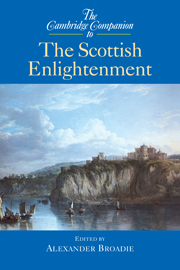Book contents
- Frontmatter
- Introduction
- 1 The contexts of the Scottish Enlightenment
- 2 Religion and rational theology
- 3 The human mind and its powers
- 4 Anthropology: the ‘original’ of human nature
- 5 Science in the Scottish Enlightenment
- 6 Scepticism and common sense
- 7 Moral sense and the foundations of morals
- 8 The political theory of the Scottish Enlightenment
- 9 Economic theory
- 10 Natural jurisprudence and the theory of justice
- 11 Legal theory
- 12 Sociality and socialisation
- 13 Historiography
- 14 Art and aesthetic theory
- 15 The impact on Europe
- 16 The impact on America: Scottish philosophy and the American founding
- 17 The nineteenth-century aftermath
- Select bibliography
- Index
2 - Religion and rational theology
Published online by Cambridge University Press: 28 May 2006
- Frontmatter
- Introduction
- 1 The contexts of the Scottish Enlightenment
- 2 Religion and rational theology
- 3 The human mind and its powers
- 4 Anthropology: the ‘original’ of human nature
- 5 Science in the Scottish Enlightenment
- 6 Scepticism and common sense
- 7 Moral sense and the foundations of morals
- 8 The political theory of the Scottish Enlightenment
- 9 Economic theory
- 10 Natural jurisprudence and the theory of justice
- 11 Legal theory
- 12 Sociality and socialisation
- 13 Historiography
- 14 Art and aesthetic theory
- 15 The impact on Europe
- 16 The impact on America: Scottish philosophy and the American founding
- 17 The nineteenth-century aftermath
- Select bibliography
- Index
Summary
INTRODUCTION
To a modern readership the leading, and most provocative, figure writing in the philosophy of religion in eighteenth-century Scotland was David Hume. To Scots contemporaries too he was no doubt the most provocative, but he was far from leading. They sought to minimise his impact and played down his significance, and in the short term they succeeded. This was less because they had other major players than because the main traditions of thought ranged against Hume could count on enough broad support within their respective spheres to counteract a challenge that was not seen at the time particularly to tax their wits. If posterity has been less sure that they were entitled to be so complacent, it is important to be clear where the strength of opinion at the time actually lay. Accordingly, this chapter falls into three parts. The first explores the state of the subject before Hume wrote, distinguishing between an orthodox tradition for which theology was the primary science that could dictate terms of reference to philosophy, and a new, largely imported (English and Dutch), tradition of 'rational' religion that subjected the whole framework of religious belief to the same rational critique as other forms of knowledge and belief. Within the universities, this was part of a recognised adjustment of interests between divinity and arts faculties, but outside academia it generated bitter conflicts between conservative and progressive parties in the Kirk.
- Type
- Chapter
- Information
- The Cambridge Companion to the Scottish Enlightenment , pp. 31 - 59Publisher: Cambridge University PressPrint publication year: 2003
- 15
- Cited by

